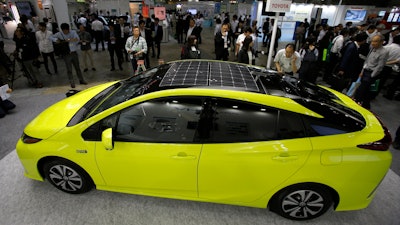
TOKYO (AP) — A top engineer at Toyota says the Japanese automaker plans to get as bullish as its rivals in pushing plug-in hybrids with the introduction of its new Prius Prime.
Toyota Motor Corp. leads the industry in hybrids, which switch between a gas engine and an electric motor. It has sold 9 million hybrid vehicles around the world since the first Prius went on sale in 1997 but only about 75,000 plug-in hybrids, which charge from a regular household plug and switch to operating as hybrids only when their batteries run low.
The first Toyota plug-in was launched in 2012, after limited leasing from 2009. It will start selling its remodeled plug-in, called the Prius Prime in the U.S. and Prius PHV in Japan, later this year.
The company is promising a whopping mileage equivalent to 120 miles per gallon, calculated including how far the vehicle goes as an electric car, without a drop of gas.
"We were just studying it thoroughly," Chief Engineer Kouji Toyoshima told The Associated Press, when asked whether Toyota had fallen behind on plug-ins. "But what we have developed is at the top level among plug-in hybrids."
The Prius Prime looks similar to a regular Prius. Toyota is aiming for a model it can sell at high volumes, with friendly styling and affordable prices, so as to have the most impact in reducing fossil fuel consumption, Toyoshima said. He said battery costs are the main obstacle for reducing prices.
Toyota has not yet announced pricing for the Prius Prime.
The vehicle's solar panel provides about 10 percent of the average driving range of a Tokyo resident, partly addressing the criticism that while electricity is emissions-free at the car level, power generation relies mostly on fossil fuels. When the Prius Prime is operating as an electric car, the generator for its hybrid feature also works with the motor to increase efficiency, Toyoshima said.
The EV's cruise range is 22 miles (35 kilometers), or long enough for about half of American commuters. That rises to about 80 percent for people who can plug in during work, according to Toyota.
Toyota was the first with the Prius, but today the market for plug-ins is crowded with offerings from General Motors, Volvo and Mitsubishi Motors and electric cars from Tesla and Nissan Motor Co.
"The new Toyota Prius Prime is facing a much tougher competitive environment," said Christian Stadler, professor of strategic management at the University of Warwick's business school. He said it makes sense for Toyota to move up-market and cater to customers who are less price-sensitive and more concerned with the environment.
Oil prices have fallen in recent months, dampening hybrid sales. But automakers are pushing ahead with ecological technologies to comply with stricter regulations on emissions and address global warming, Stadler and other analysts say.
"The Prime is in line with Toyota's image as a green automaker, and will further that image —even though it is not the first company to offer such an option," said Stephanie Brinley, senior analyst with IHS Automotive. She said the car will likely appeal to mainstream buyers, while Tesla remains the big green status symbol.






















